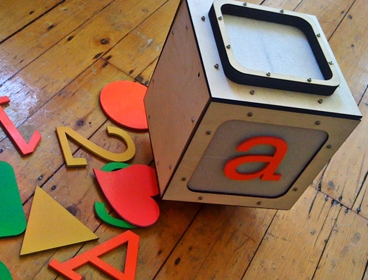When the playroom is the computer
November 23, 2010

The Alphabot, a prototype robot that appears to move seamlessly between the real world and an on-screen virtual world, is designed to resemble a child's alphabet block. (Photo: David Robert)
Researchers at the MIT Media Laboratory have developed an educational-media system using a block-shaped robot that gets kids out of their chairs.
The prototype of the Playtime Computing system consists mainly of three door-high panels with projectors behind them; a set of ceiling-mounted projectors that cast images onto the floor; and a cube-shaped, remote-controlled robot, called the Alphabot, with infrared emitters at its corners that are tracked by cameras mounted on the ceiling.
The purpose of the system is to give children between the ages of 4 and 6 an opportunity for what developmental psychologists call “imaginative play”: early experimentation with symbolic reasoning and social roles that’s crucial to cognitive development. The researchers also want to get kids out of their chairs.
Wooden symbols that can be attached to the face of the Alphabot. Each symbol contains an RFID tag, and inside the Alphabot is a tag reader. If a child changes the symbol on the Alphabot, the Alphabot’s face changes its color to match that of the symbol.
Adapted from materials provided by MIT
